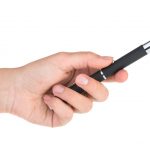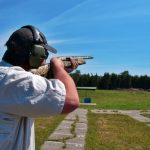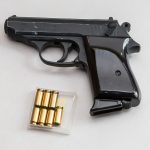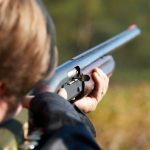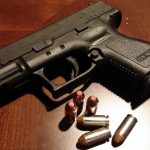Man Prosecuted for Possessing ‘Gel Blasters’
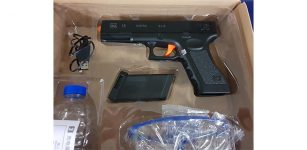
A Coffs Harbour man is facing charges of illegally possessing firearms after allegedly being caught with several ‘gel blasters’ he intended to give to his son as Christmas gifts.
The story so far…
At around 1.45am on 23rd December 2018, NSW Highway Patrol officers stopped a car at Tweed Heads for a random breath test.
Upon doing initial checks, the officers decided to search the vehicle.
During that search, police allegedly located a number of ‘gel blasters’, which are marketed in Queensland as items “classified as a toy… powered by a battery or manual loaded spring that shoot non harmful gel balls”.
Police reported the items to include a Colt M4, Glock 18, Scar sub machine gun, STD water gun electric fire, MP52 sub machine gun, MP7 crystal bullet model and M249 machine gun.
Police also allegedly located 0.35 grams of cannabis.
A male passenger allegedly admitted owning the items, telling police he bought them in Queensland as a Christmas gift for his son.
He was arrested and charged with 14 counts of unauthorised possession of a firearm and one count of possessing an illegal drug.
The man was refused police bail.
The Facebook post
The NSW Police Force Traffic and Highway command published the following post on their Facebook page later that morning:
“At 1.45am on Sunday 23 December 2018 Northern Borders Highway Patrol stopped a vehicle on Leisure Dr Tweed Heads for the purpose of Random Breath Testing. After a number of enquiries Police had cause to search the vehicle. During that search a number of replica ‘Gel Blaster’ firearms were located in the vehicle. These firearms all resembled the real weapons and are capable of firing gel projectiles. A 31 year male from Coffs Harbour, who was the rear seat passenger in the vehicle, admitted ownership of all firearms stating he had purchased them in the state of QLD for his son for Christmas. Also located was 0.35g of Cannabis which police will allege belonged to the 31 year old male.
The firearms include;
Colt M4
Glock 18
Scar sub machine gun
STD water gun electric fire
MP52 sub machine gun
MP7 crystal bullet model
M249 machine gun
The 31 year old male from Coffs Harbour has been charged with possess prohibited drug and 14 counts of possess unauthorised pistol / firearm, and was bail refused to appear at the Tweed Heads Local Court later today.”
The reaction
The post has attracted several thousand comments, the overwhelming majority of which are negative.
Many readers blasted the police force for ruining a man’s Christmas over what are essentially toy guns, calling upon them to go after real criminals rather than a man who legally purchased toys as a gift for his son.
Among the most popular comments are:
“I can’t believe you guys actually posted this to Facebook like you’re proud of it… It must be embarrassing seeing the general public rip apart the charges. Hopefully it puts some context around it. Yeah it’s the law, but it’s utterly ridiculous, and the people agree. You’re going to ruin a young Dad’s life with these charges, because he had some toys. Congratulations.”
“Those were a kids Christmas toys. You have just ruined someone’s life, possibly a family, over toys and not even a gram cannabis. How do you sick fucks sleep at night?”
“Watch out Traffic and Highway Patrol Command – NSW Police Force, I hear this 24th, a large shipment from overseas is coming in too. Perps name is Santa Claus. He’ll be coming in via an aerial route. He’ll be dropping toys all over NSW. He is using old school reindeer sledge (capable of flying) with 8 reindeer. Perhaps an additional one called Rudolph. Big Red Nose!”.
“These firearms include; NO FIREARMS. We confiscated toys.”
“Bail refused for plastic guns but rock spiders junkies etc walk free ohh yer makes sense.”
“A colt m4, a glock and scar sub machine gun was found along with 4 million in Monopoly money. Man charged with firearms and undeclared finances.”
“Title should read NSW police steal children’s Christmas presents.”
“Officer: Sarg, I’m gonna need back up! This guy in heavily armed with military water pistols….”.
“You arrested a man for toys and enough weed to pack a bowl ? id be embarrassed as a cop if i had that as an arrest.”
“Nice to see where the law and court system lies. Deny a bloke bail from seeing his kids for Xmas for buying them toys. But give kiddy fiddlers and murderers bail… what reasonable cause does a cop need to search a vehicle during a RBT. You do know Nsw pol this hobby/sport is growing at a rapid rate. Learn to embrace it. Never know you may actually have fun ?”.
“3 dollars worth of weed and fake guns. Wow guys Im glad you’re patrolling and keeping and us safe from this guy. He might have had a good time playing with his son.”
“Next someone gonna be charged with human trafficking after they get caught with a box of barbies they bought for their daughter lol.”
“If this is real you should be nothing but ASHAMED of yourselves.”
“And you post this on your Facebook page as some sort of accomplishment? Some toys and barely enough weed to roll a joint? I would laugh but some young man actually got arrested for this.”
The law
The incident raises a number of questions regarding the legality of the search, the laws relating to exclusive possession and the sustainability of the firearms charges.
Legality of search
Police are not permitted to arbitrarily search a person or their vehicle without a warrant.
In relation to cars, section 36 of the Law Enforcement (Powers and Responsibilities) Act 2002 give police officers the power to stop, search and detain a vehicle without a warrant if it is suspected on reasonable grounds that:
- the vehicle contains, or a person in the vehicle has in his or her possession or under his or her control, anything stolen or otherwise unlawfully obtained, or
- the vehicle is being, or was, or may have been, used in or in connection with the commission of a relevant offence, or
- the vehicle contains anything used or intended to be used in or in connection with the commission of a relevant offence, or
- the vehicle is in a public place or school and contains a dangerous article that is being, or was, or may have been, used in or in connection with the commission of a relevant offence, or
- the vehicle contains, or a person in the vehicle has in his or her possession or under his or her control, a prohibited plant or prohibited drug, or
- circumstances exist on or in the vicinity of a public place or school that are likely to give rise to a serious risk to public safety and that the exercise of the powers may lessen the risk.
The leading case on the meaning of reasonable suspicion is R v Rondo (2001) 126 A Crim R 562.That case was presided over by Chief Justice Spigelman, and Justices and Simpson and Smart.
The most pertinent (and most frequently quoted) part of the judgment is paragraph [53] where, after reviewing several authorities, Justice Smart finds that ‘the following propositions emerge’:
“(a) A reasonable suspicion involves less than a reasonable belief but more than a possibility.
There must be something which would create in the mind of a reasonable person an apprehension or fear of one of the state of affairs covered by s.357E [which is the predecessor to the current sections].
A reason to suspect that a fact exists is more than a reason to consider or look into the possibility of its existence.
(b) Reasonable suspicion is not arbitrary. Some factual basis for the suspicion must be shown.
A suspicion may be based on hearsay material or materials which may be inadmissible in evidence. The materials must have some probative value.
(c) What is important is the information in the mind of the police officer stopping the person or the vehicle or making the arrest at the time he did so.
Having ascertained that information the question is whether that information afforded reasonable grounds for the suspicion which the police officer formed. In answering that question regard must be had to the source of the information and its content, seen in the light of the whole of the surrounding circumstances”.
Key parts of Justice Smart’s summation are:
- to form a reasonable suspicion, there must be “more than a possibility”of one of the listed states of affairs, in other words “more than a reason to consider or look into the possibility of its existence”.
- reasonable suspicion is not arbitrary. Some factual basis for the suspicion must be shown”.
- when deciding if there was a reasonable suspicion, “regard must be had to the source of the information and its content, seen in the light of the whole of the surrounding circumstances”.
A failure to comply with this requirement of reasonable suspicion will render a search unlawful.
In that event, section 138 of the Evidence Act 1995 (NSW) provides that any evidence derived pursuant the search is liable for exclusion if the desirability of admitted the evidence (in the case of the Coffs Harbour man, the evidence of the gel blasters in respect of the firearms charges and 0.35 grams of cannabis for the drug possession charge) is outweighed by the undesirability of admitting evidence obtained in that manner.
In deciding whether to exclude the evidence, the court will look at:
(a) the probative value of the evidence;
(b) the importance of the evidence in the proceeding;
(c) the nature of the offence,
(d) the gravity of the illegality,
(e) whether it was deliberate or reckless; and
(f) whether it breaches the International Covenant on Civil and Political Rights; and
(g) whether any other proceedings may be taken in relation to the illegality; and
(h) the difficulty (if any) of obtaining the evidence without the illegality.
It is important to note that an otherwise illegal search will become legal if the driver gives ‘informed consent’ to the search.
In the case of the Coffs Harbour man, the factual basis upon which police claimed to have formed the reasonable suspicion for a search of the vehicle is unclear.
Requirement to prove exclusive possession
The case of Filippetti (1984) 13 A Crim R 335 and a long line of cases to follow are authority for the proposition that for a possession charge to be established, the prosecution must prove beyond reasonable doubt that the item allegedly possessed was in the defendant’s “exclusive physical control”.
So, for example, if drugs or guns are found in the common area of a home or within a car occupied by more than one person, or in the boot of a car accessed by more than one person, the prosecution must negate beyond reasonable doubt any possibility the items were possessed by someone other than the defendant.
In the case of the man from Coffs Harbour, police claim he made admissions to being the owner of the gel blasters – which may be enough to overcome the requirement to prove exclusive possession.
Firearms charges
Commonwealth laws regulate the importation of items into Australia.
Regulation 4F of the Customs (Prohibited Imports) Regulations 1956 prohibits the importation or firearms, firearm components and imitation firearms unless the requirements of Schedule 6 are satisfied, in which case the government grants permission to import.
Department of Home Affairs Notice No. 2017/43 is titled ‘Revised treatment of gel ball blasters and similar low powered devices’ and essentially makes it legal to import these items.
State legislation governs the legality of selling and possessing firearms and weapons.
Gel blasters are currently legal to sell and possess without a licence in Queensland and South Australia.
The Coffs Harbour man’s purchase and possession of gel blasters in Queensland was therefore perfectly legal.
The offence of unauthorised possession of a firearm in NSW
In New South Wales, section 7 of the Firearms Act 1996 prescribes a maximum penalty of 14 years’ imprisonment for anyone who possesses or uses a pistol or prohibited firearm unless the person is authorised to do so by a licence or permit.
Section 4 of the Act defines a pistol as a firearm that:
- is reasonably capable of being raised and fired by one hand, and
- does not exceed any dimension prescribed by the regulations.
A list of prohibited firearms is contained in Schedule 1 of the Act.
Section 7A sets down a five year maximum penalty for anyone who possesses or uses a firearm unless the person is authorised to do so by a licence or permit.
Section 4 defines a firearm as a gun, or other weapon, that is (or at any time was) capable of propelling a projectile by means of an explosive, and includes a blank fire firearm, or an air gun, but does not include anything declared by the regulations not to be a firearm.
If manufacturer descriptions are correct, and the gel balls are propelled by a spring rather than ‘by means of an explosive’ or an ‘air gun’, it would seem gel blasters are not captured by this definition.
Imitation firearms
However, section 4D of the Act sets out ‘special provisions relating to imitation firearms’.
The section defines an imitation firearm as “an object that, regardless of its colour, weight or composition or the presence or absence of any moveable parts, substantially duplicates in appearance a firearm but that is not a firearm.”
Significantly, the section makes clear that for the purposes of offences under the Firearms Act:
- an imitation firearm that is an imitation of a pistol is taken to be a pistol, and
- an imitation firearm that is an imitation of a prohibited firearm is taken to be a prohibited firearm.
This ensures that offence sections such as 7 and 7A extend to imitation firearms.
Those who wish to legally possess or use imitation firearms in NSW are required to obtain a permit from the Police Force.
However, it is important to note that section 4D makes clear that “an imitation firearm does not include any such object that is produced and identified as a children’s toy.”
The upshot is that if the gel blasters were produced and identified as children’s toys, they would not be capable of giving rise to convictions for unauthorised firearm possession charges.
If they were not, they may be capable of leading to convictions in the absence of a permit.
These are factual matters that would need to be the subject of representations to the prosecution by the Coffs Harbour man’s criminal defence lawyers, or ventilated inside the courtroom.
Charged with a firearms offence?
If you are going to court for a firearms charge, call us anytime on (02) 9261 8881 to arrange a free conference with an experienced criminal defence lawyer.
We have offices in the Sydney CBD, throughout the Sydney metropolitan area and in Newcastle and Wollongong.
If you are unable to make it to one of our offices, we can arrange a conference over the phone or by Skype/Zoom.


